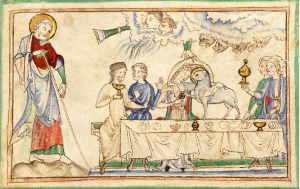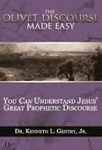THE MARRIAGE SUPPER OF THE LAMB
 PMW 2021-008 by Kenneth L. Gentry, Jr. (with Milton S. Terry)
PMW 2021-008 by Kenneth L. Gentry, Jr. (with Milton S. Terry)
The New Testament has many images of the glory of Christ’s kingdom and our joyous salvation in it. One of the most glorious images is that of a joyful marriage supper. Though this image appears directly in several New Testament passages (e.g., Matt. 22:2ff; 25:2ff) and indirectly in others, one of the most impressive presentations is in the Book of Revelation.
Milton Terry on the Supper
In his Biblical Apocalyptics (p. 441), Milton S. Terry comments on the marriage supper of the Lamb as presented in Revelation:
In [Revelation 19:9] below mention is made of “the supper of the marriage of the Lamb.” The song being cast in a prophetic mold, things future are conceived as already complete and hence the aorists of this verse, “came” (elthen)) and “made ready” (hetoimasen). The marriage of the Lamb is the union of Christ with believers and is therefore essentially a fact of spiritual life.
The feast or supper of that marriage is a figure for the delightful fellowship, the blessed entertainment and fruition of such vital union with the Prince of life. The marriage of the Lamb is a process continually going on as long as such unions of Christ and his beloved and elect ones continue to be consummated. The glory and blessedness of life with Christ in heaven are but the perpetuation of the union formed by faith and love in this world.
The marriage and feast of this apocalyptic song are accordingly to be understood as referring to the same spiritual fact as the parables of the marriage of the king’s son in Matthew 22:2–13 and the great supper in Luke 14:15–24.
“His wife hath made herself ready” — In apocalypse as in parable facts or great truths which continue for ages are necessarily pictured in harmony with the figure employed. The union of one believer with Christ is a representative of all such unions of all time. But to conserve the figure of a marriage feast the entire process of ages is conceived as complete.
Three Views on the Millennium and Beyond
(ed. by Darrell Bock)
Presents three views on the millennium: progressive dispensationalist, amillennialist, and reconstructionist postmillennialist viewpoints. Includes separate responses to each view. Ken Gentry provides the postmillennial contribution.
See more study materials at: www.KennethGentry.com
Gentry comments
Terry well captures an important truth regarding the marriage supper which is missed by too many. The marriage supper is neither a one-time event at the beginning of Christian history nor an event punctuating the end of Christian history and the introduction of the final eternal estate. Rather it is an image of the ongoing calling and saving of sinners which brings them into the joyous continuing celebration of union with Christ.
Thus, the marriage supper began in the first century and continues until the last day. As Terry puts it: “The marriage of the Lamb is a process continually going on as long as such unions of Christ and his beloved and elect ones continue to be consummated.” And: it will “continue for ages.”
The marriage of the Lamb necessarily includes all the saints of God. Therefore, the marriage supper cannot be a completed event, for men and women are continually being saved and brought into union with Christ. And the ongoing joy of the Christian life is well captured by the picture of a wondrous celebration of that life in union with Christ.

Olivet Discourse Made Easy (by Ken Gentry)
Verse-by-verse analysis of Christ’s teaching on Jerusalem’s destruction in Matt 24. Shows the great tribulation is past, having occurred in AD 70, and is distinct from the Second Advent at the end of history.
See more study materials at: www.KennethGentry.com
Tragically, the Jewish nation rejected Christ and God’s gracious invitation to enter into the supper (Matt. 22:1–6) and were judged because of that (Matt. 22:7). Yet, God has sent out messengers to continually gather us in (Matt. 22:8–10), though only those who have truly readied themselves (i.e., been truly converted by God’s grace) will be accepted (Matt. 22:11–14). This ongoing mission is directed by the Great Commission, which engages “all nations” until the end comes.
Kenneth L. Gentry Jr.'s Blog
- Kenneth L. Gentry Jr.'s profile
- 85 followers



